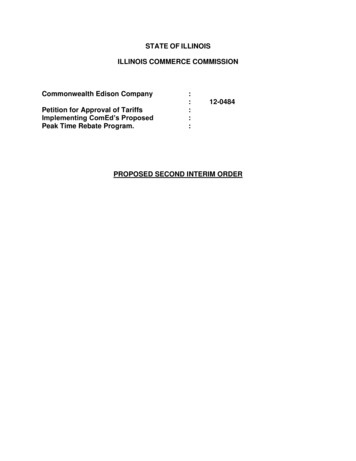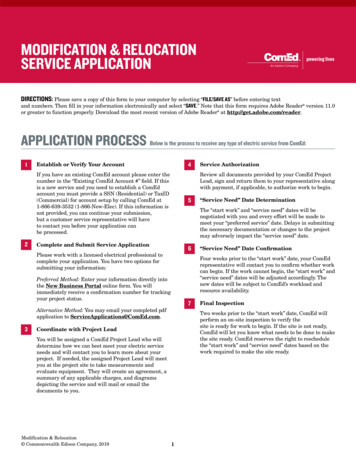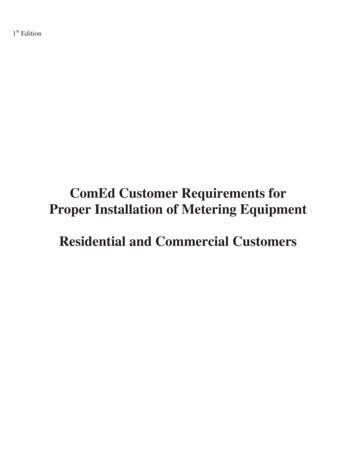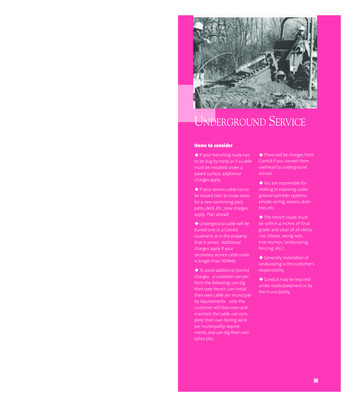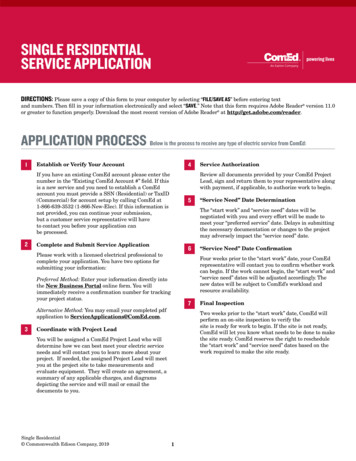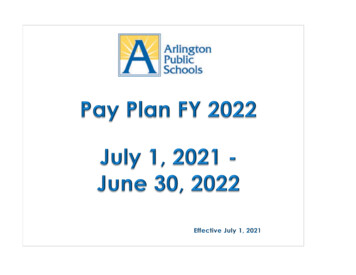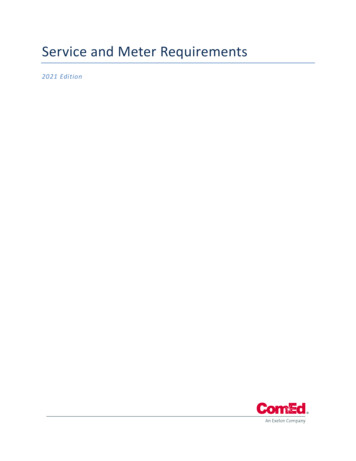
Transcription
ComEd’sHourly PricingProgram Guide
TABLE OFCONTENTS2The Hourly Pricing Program3Saving and Making a Difference4Comparing Your Rate Options8Managing Costs with Hourly Pricing9Tools to Help You Save11Understanding Your Bill14
THE HOURLY PRICING PROGRAMComEd’s Hourly Pricing, a program enabled by your home’s smart meter, is an energysupply rate option for residential customers that allows you to pay the hourly marketprice for electricity. By shifting some of your energy use to lower-priced hours, you cansave money on your monthly bills.As an Hourly Pricing program participant, you’ll have tools to help you save that youcan access whether you’re at home or on the go.These services include Hourly Pricing Alerts, an online bill comparison tool, a mobileapp, and additional information to help guide your energy decisions.This guide provides an overview of the Hourly Pricing program, tips on managingcosts with Hourly Pricing, and a detailed explanation of the line items that appear onparticipants’ energy bills.3
SAVING AND MAKING A DIFFERENCEIT’S SIMPLE TO SAVE ON HOURLY PRICINGTake advantage of lowenergy prices duringmornings, nights,and weekends.We’ll monitor prices andoccasionally send youalerts so you know the besttimes to use less energy.When you receive analert, delay using largeappliances until later in theday and you could save.*We’ll send youmonthly savingsreports via email.* High-price periods don’t typically last more than an hour. You can check real-time prices via the ComEd mobile appor at ComEd.com/HourlyPricing.4
SAVING AND MAKING A DIFFERENCEHOURLY MARKET PRICESHEALTHIER ENVIRONMENTComEd’s Hourly Pricing program gives you access tohourly electricity prices that are based on the ResidualComEd Zone PJM wholesale market prices. These pricesvary from hour to hour and day to day according tothe actual market price of electricity. You can manageyour costs with Hourly Pricing by using appliances thatconsume a lot of energy during lower-priced hours andconserving energy during hours when prices are higher.By controlling and shifting your energy use to lower-pricedhours, you’ll not only save money, but you’ll also helpreduce energy demand during peak times when the use ofolder, less efficient generation facilities is often needed. Inthis way, you’ll help reduce the release of emissions thatcontribute to global climate change.5
SAVING AND MAKING A DIFFERENCESince 2007, Hourly Pricing participants have saved: 23 million and 65 million kWhParticipants have helped prevent58,193 metric tons of greenhousegas emissions from entering theatmosphere. That’s equal to the weightof 10,691 African Elephants.It’s also the amount of carbon capturedby 68,489 acres of forest in a singleyear, which is nearly half the land areaof the City of Chicago!6
SAVING AND MAKING A DIFFERENCEWE’RE HERE FOR YOUThe Hourly Pricing program gives you personalized information, tools, and services to help you take control of yourenergy costs. As a participant, you’ll receive:Information and tipsto help you reduceyour energy costs.Access to electricityprice updates onlineand by phone so youcan decide how andwhen to use energy.Online tools that help youunderstand your savingsand usage as well as coolways to save.Support fromprogram specialistswho are just a liveonline chat, email, orphone call away.7
COMPARING YOUR RATE OPTIONSThe main difference between ComEd’s two rates is how you pay for your energy supply.HOURLY PRICINGSTANDARD FIXED-PRICE RATEWith Hourly Pricing, the price of electricity varies fromhour to hour based on wholesale market prices. Your billwill show the total cost for the energy used, calculatedusing these hourly prices and your corresponding hourlyenergy use measured by your home’s smart meter.ComEd does not mark up or profit from the price ofelectricity; you simply pay the market price.With ComEd’s standard fixed-price rate, you pay a setprice for your energy supply. This price varies by seasonand is adjusted periodically, but it does not change fromhour to hour or day to day.Regardless of your energy supply choice (Hourly Pricingrate, standard fixed-price rate, or other alternativesupply option), all residential customers are required topay the same Delivery Service charges. These chargesfinance the maintenance of the poles, wires, and servicesrequired to deliver energy to your home, and they areshown separately on your energy bill.8Note: If you are currently participating in ComEd’s NetMetering program (Rider Parallel Operation of RetailCustomer Generating Facilities with Net Metering orP O G N M) and you switch your rate to the Hourly Pricingprogram, your net metering credits will be calculated as adollar value at the time of generation. For more informationon your current kWh credits or the Net Metering programin general, call 800‑825-5436 or emailGPCTeam@ComEd.com.
MANAGING COSTS WITH HOURLY PRICINGHourly electricity prices typically change as the demand for energy changes; higher demand usually means higherhourly prices. Average prices tend to be higher during weekdays and lower during early mornings, nights, andweekends. Demand and price patterns also vary by season. By keeping these patterns in mind, you can wisely manageyour energy use and save money.TYPICAL REAL-TIME PRICING PATTERNS*Summer Price PatternNormally the highest prices in the summer will be inthe late afternoon and early evening. Energy pricestypically fluctuate the most during the summerbecause energy demand fluctuates considerablyas businesses and households turn their airconditioners on and off. When temperatures areespecially high, hourly prices can rise significantly.Fall, Winter, and Spring Price Pattern* Based on average prices for January 2016 through December 2019.Non‑summer months include October through May. Summermonths include June through September.During the cooler months, there tends to be a pricespike in the morning and evening, and prices aretypically lower overall than in the summer.9
MANAGING COSTS WITH HOURLY PRICINGOTHER FACTORS THAT IMPACT REAL-TIME PRICES The weather can impact the real-time price of electricity,particularly during the summer when air conditioner usedrives up demand for energy. During the winter, electricity prices can increase whenthere is a sudden and significant temperature drop orwhen extended cold snaps push up natural gas prices. Prices can sometimes increase in the spring or fall ifa heat wave occurs when some power plants are shutdown for maintenance. There can also be unexpected and brief price spikesif multiple power plants have technical or mechanicalproblems at the same time.A NOTE ABOUT NEGATIVE PRICESWith real-time hourly market prices, it is possible for the price of electricity to be negative for short periods of time.This typically occurs in the middle of the night and, under certain circumstances, when energy supply is far greaterthan demand. In the market, some types of electricity generators cannot or prefer not to reduce energy output forshort periods of time when demand is insufficient, and, as a result, some generators may provide electricity to themarket at prices below zero. Since Hourly Pricing participants pay the market price of electricity, it’s like getting paidto use energy, though other charges still apply.10
TOOLS TO HELP YOU SAVECENTRAL AC CYCLINGLOAD GUARD AUTOMATIC PRICE RESPONSE SERVICE If you have central air conditioning, you can sign up forComEd’s Central AC Cycling, which allows ComEd tocycle your air conditioner’s compressor off and on duringsummer days when demand for energy is highest. If enrolled in ComEd’s Central AC Cycling, Hourly Pricingparticipants can also sign up for the Load Guard AutomaticPrice Response Service, which is an automatic air conditionercycling option designed especially for participants. When you sign up for ComEd’s Central AC Cycling programon a direct load control switch, you will receive a credit of 5 or 10 each month (depending on which cycling optionyou select) on your June through September ComEd bills. Load Guard automatically cycles your air conditioner’scompressor off and on during high-priced hours to help yousave money, so you have one less thing to worry about.To enroll or learn more about ComEd’s Central AC Cycling and Load Guard, go to ComEd.com/HourlyPricingor call 888-202-7787.11
TOOLS TO HELP YOU SAVEHOURLY PRICING ALERTSACCESS TO PRICE INFORMATION Hourly Pricing Alerts can help you save money by telling you toshift energy use either now or tomorrow. You can receive alertsvia email, text message, or automated phone call. To sign up orchange your alert preferences, sign in to your My Hourly PricingAccount or email us at info@ComEdHourlyPricing.com. Each evening, day-ahead prices are available online andby phone at 888-202-7787. An alert that tells you to save energy immediately is sent whenthe real-time market price of electricity is trending high. You also can go to ComEd.com/HourlyPricing to viewhourly electricity prices throughout the day. A different alert that tells you in advance to reduce yourenergy use tomorrow during specific hours can help reducethe Capacity Charge on your future energy bills.12 You can use these day-ahead prices to help you plan howand when you use energy.
TOOLS TO HELP YOU SAVEMY HOURLY PRICING ACCOUNTMOBILE APP Hourly Pricing participantscan access specialized tools inComEd’s free mobile app so youcan easily check prices, view yoursavings information, and quicklyconnect to program specialists. Download the free ComEd mobileapp for flexibility, convenience,and control at your fingertips. Each month after your bill is calculated, you will be able tolog in to your My Hourly Pricing Account, which is separatefrom your ComEd.com account, to access a breakdownof your hourly energy use and costs. You’ll also be able tocompare your costs with Hourly Pricing to what you wouldhave paid on ComEd’s standard fixed-price rate. The tools available only to Hourly Pricing participants can befound by opening the app and navigating to “Check Up On YourHourly Pricing Savings” towards the bottom of the main screen.FREQUENTLY ASKED QUESTIONS For more information about the Hourly Pricing program andavailable tools, visit HourlyPricing.ComEd.com/FAQs.13
UNDERSTANDING YOUR BILLSome of the line items and charges will bethe same for both participants in ComEd’sHourly Pricing program and ComEd’sstandard fixed-price rate customers.Some line items will be different or willbe calculated based on different rates. Allline items under Section B, Delivery, andSection C, Taxes & Fees, are calculatedthe same way for all residential customers.Here is an example of the line itemson your bill and how the charges forHourly Pricing participants differ fromthe charges for customers on ComEd’sstandard fixed-price rate. All chargeson ComEd bills are based on tariffs andriders approved by the Illinois CommerceCommission. ComEd’s full rate book isavailable online and should be consideredthe official record for these items.Go to ComEd.com/Rates and click onComEd’s Entire Schedule of Rates forElectric Service to view ComEd’s fullrate book.14A.B.C.
UNDERSTANDING YOUR BILLHOW YOUR HOURLY PRICING BILL DIFFERSA.Under supply-related charges, all customers willhave an Electricity Supply Charge, a TransmissionServices Charge, and a Purchased ElectricityAdjustment. However, the rates for these line itemsare different for Hourly Pricing participants andComEd’s standard fixed-price rate customers.HOW YOUR HOURLY PRICING BILL IS THE SAMEB.C.The Delivery and Taxes & Fees sections use thesame rates for Hourly Pricing participants andcustomers on ComEd’s standard fixed-price rate.Hourly Pricing bills include separate line itemsfor the Capacity Charge and the MiscellaneousProcurement Charge. A standard fixed-price ratebill includes the costs for these two line items in theElectricity Supply Charge.15
UNDERSTANDING YOUR BILLDIFFERENCES IN HOW SUPPLY CHARGES ARE CALCULATEDElectricity Supply ChargeComEd’s standard fixed-price rate Electricity SupplyCharge is based on the costs of procuring electric powerand energy. This charge includes the cost for the electricenergy, capacity, and other miscellaneous costs. All ofthese components are purchased together and combinedinto one Electricity Supply Charge for standardfixed-price rate customers.The Hourly Pricing Electricity Supply Charge is basedon the real-time hourly prices, but it does not includecapacity costs or miscellaneous costs. Therefore, HourlyPricing participants have separate Capacity Charge andMiscellaneous Procurement Component Charge line items.16Transmission Services Charge and PurchasedElectricity AdjustmentThe Transmission Services Charge is different for HourlyPricing participants and for customers on ComEd’sstandard fixed-price rate because the supply for each isprocured differently. For a similar reason, Hourly Pricingparticipants’ Purchased Electricity Adjustment (P E A)charge or credit is different from the charge or credit forstandard fixed-price rate customers.
UNDERSTANDING YOUR BILLANSWERS TO YOUR QUESTIONS ABOUT SPECIFIC LINE ITEMSQ.Why do I pay a different Transmission ServicesCharge with the Hourly Pricing program?A.On the standard fixed-price rate, ComEd purchasestransmission services for all standard fixed-price ratecustomers. This charge is then apportioned to differentcustomer groups on the standard fixed-price rate,resulting in different Transmission Services Chargerates for residential, commercial, and industrialcustomers. On the Hourly Pricing rate, ComEd purchasestransmission services for all hourly rate participants, sothe Transmission Services Charge rate is the same for allhourly customers (residential, commercial, and industrial).Q.A.What is the Purchased Electricity Adjustment?The Purchased Electricity Adjustment (P E A) is a chargeor credit that adjusts for the difference, if any, between thecost for electricity supplied and the revenue received fromcustomers for that electricity. This is reviewed monthly,and the charge rate is adjusted accordingly. The supplycosts are tracked (and the P E A is adjusted) separately fordifferent customer groups, so it may differ between HourlyPricing participants and customers on ComEd’s standardfixed-price rate.Q.What is the Miscellaneous ProcurementComponent Charge?A.The Miscellaneous Procurement Component Charge isa line item for Hourly Pricing participants only. Thischarge recovers the costs that ComEd incurs relatedto procuring electric power and energy for HourlyPricing customers that are not recovered through theCapacity Charge, the Electricity Supply Charge, andthe Transmission Services Charge. Similar costs forcustomers on ComEd’s standard fixed-price rate areincluded in their Electricity Supply Charge.17
UNDERSTANDING YOUR BILLANSWERS TO YOUR QUESTIONS ABOUT SPECIFIC LINE ITEMSQ.A.What is the Capacity Charge?The Capacity Charge allows ComEd to reserve generatingcapacity in advance, ensuring that enough energy willbe available when it is needed, even at peak times. Allelectricity suppliers are required to reserve capacity tocover each customer’s Capacity Obligation. The CapacityObligation represents your expected level of hourly energyuse in the afternoon on a hot summer day.For residential customers who pay ComEd’s standardfixed-price rate, capacity costs are included in theirElectricity Supply Charge. For Hourly Pricing participants,the Electricity Supply Charge does not include thesecapacity costs, so ComEd lists this as a separate CapacityCharge line item on Hourly Pricing bills.As the market price of capacity fluctuates, all ComEdcustomers will see adjustments to their rate. The CapacityCharge item on your bill is adjusted annually in June.For more information on the Capacity Charge andhow you can lower it on future bills, visitHourlyPricing.ComEd.com/FAQs.18Q.A.How is the Capacity Charge calculated?There are two components to this charge: your CapacityObligation and the Capacity Charge rate. Multipliedtogether, they make up the Capacity Charge item onyour bill.Your Capacity Obligation reflects how much energyyou were using last summer when energy was most indemand. The method used to calculate your individualCapacity Obligation depends on when your smart meterwas installed. The Capacity Charge Rate is updated eachJune based on the market, and your actions won’taffect it.
UNDERSTANDING YOUR BILLFOR MORE INFORMATIONQ.A.How can I reduce my Capacity Charge in the future?Learn more about ComEd’s Hourly Pricing program:Reducing your energy use during peak hours (which havehistorically occurred between 1 p.m. and 5 p.m. on thehottest weekdays of summer) could lower your CapacityCharge on future bills.Online: ComEd.com/HourlyPricingEmail: info@ComEdHourlyPricing.comCall: 888-202-7787If you sign up for Hourly Pricing Alerts, you’ll always beprepared for peak hours. When ComEd anticipates thatenergy will be most in demand, they’ll send you an alertthe day before so you can plan to use less. By reducingenergy use during peak hours, you may lower yourCapacity Obligation, and thus, your Capacity Charge onfuture bills.You can sign up for or change your alert preferences inyour My Hourly Pricing Account or by emailing us atinfo@ComEdHourlyPricing.com.19
Commonwealth Edison Company, 2020
ComEd's Central AC Cycling, which allows ComEd to cycle your air conditioner's compressor off and on during summer days when demand for energy is highest. When you sign up for ComEd's Central AC Cycling program on a direct load control switch, you will receive a credit of 5 or 10 each month (depending on which cycling option
